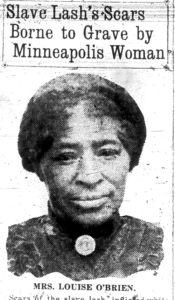
The building where St. James”' members worship today is 60 years old; it is a modest and beautiful church that is lovingly maintained. It was designed by architect Irwin H. Kilstofte and constructed at its current location in 1959. On February 27, 2018, the Heritage Preservation Commission voted unanimously to approve that request. One questions was: “Is it about the people or is it about the building?” It”'s an interesting question and one where the answer does not have to be “either/or” but can be “both/and.” | Courtesy Mpls. Community Planning and Economic Development
By SUE HUNTER WEIR
In April 2017, Reverend Michael Gonzales submitted an application to the City of Minneapolis requesting that St. James A. M. E. Church (located at 3600 Snelling Avenue) be considered for landmark status. The request was an expression of the congregation”'s love for their church and their desire to preserve the work and stories of the church”'s past for its present and future members and to share their stories with the larger community.
On February 27, 2018, the Heritage Preservation Commission voted to approve that request and forward it to the City Council for their approval. The Commission”'s vote was unanimous and the only question that came up was about the church”'s period of significance. Did the period of significance for the church begin when the congregation first met or when they moved into the church that”'s being awarded landmark status? Is it about the people or is it about the building? It”'s an interesting question and one where the answer does not have to be “either/or” but can be “both/and.”
The building where St. James”' members worship today is 60 years old; it is a modest and beautiful church that is lovingly maintained. It was designed by architect Irwin H. Kilstofte and constructed at its current location in 1959.
St. James”' congregation dates back to the early 1860s making it not only the oldest African-American congregation in the City but in the State. Because it was the first, it is often referred to as Mother St. James. Some of its founding members, including Paul Brown and Mattie Williams, are buried in Minneapolis Pioneers and Soldiers Memorial Cemetery.
The first prayer meetings were held in Mr. Brown”'s Southeast Minneapolis home in 1863. Mr. Brown was born in Missouri in 1830 and moved to Minnesota sometime around the beginning or shortly after the start of the Civil War. His wife and two daughters were founding members of
St. James. Mr. Brown continued to live in Southeast Minneapolis from the time that he arrived here until his death. He worked as an expressman, a security guard who transported valuable goods. Mr. Brown died on November 2, 1905, from smoke inhalation, the result of an accidental fire.
The details of Mattie Williams”' life, as recorded in the census and other sources, are often contradictory. What we do know is that she was born in Alabama in 1843, making it likely that she was born into slavery, which raises, but doesn”'t answer, the question of how or why she came to Minnesota either before or in the early years of the Civil War. We know that she was married to Thomas Williams, who worked as a lath sawyer, and that they do not appear to have had any children. Mrs. Williams died on August 11, 1909, from heart disease at the age of 67. The Appeal, the Twin Cities”' leading African-American newspaper at the time of her death, said of her: “She had been a member of St. James for many years. She was beloved by all who knew her. She had lived a splendid Christian life. She will be missed from her familiar place in St. James church.”

Louise O”'Brien a long-time member of the congregation. She was born in Virginia around 1850 and lived in Grinnell, Iowa, where her children were born, before relocating to Minneapolis. Her obituary in the Minneapolis Journal carried the headline “Slave Lash”'s Scars Borne to Grave by Minneapolis Woman,” and described a brutal beating that she endured when she was only eight years old. | COURTESY Minneapolis Journal Aug. 18, 1915
Louise O”'Brien became a member of St. James somewhat later but was another long-time member of the congregation. She was born in Virginia around 1850 and lived in Grinnell, Iowa, where her children were born, before relocating to Minneapolis. Her obituary in the Minneapolis Journal carried the headline “Slave Lash”'s Scars Borne to Grave by Minneapolis Woman,” and described a brutal beating that she endured when she was only eight years old. She had four children who lived to adulthood but two of her sons died while in their twenties. Reverend E. R. Edwards, pastor of St. James at the time of Mrs. O”'Brien”'s death, said of her: “I knew that Mrs. O”'Brien had suffered and I knew that she had been a slave, but she never complained and was one of the cheeriest members of my congregation.” Mrs. O”'Brien died from heart disease on August 15, 1915””a sobering reminder that we are not as far removed from slavery as we might think.
Between 1860 and 1959 the congregation moved often, sometimes by choice, sometimes not. They raised money for a new and permanent home””one that would help preserve their stories””by organizing concerts, lectures, bazaars and apple-dumpling festivals. By nominating their church for landmark status, the congregation has honored its former members and their work and preserves their legacy for current and future members of the church and the wider community. Congratulations and thank you to the members of St. James!
Sue Hunter Weir is a Phillips resident









